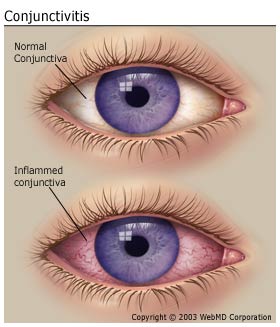

Introduction
Conjunctivitis, commonly known as pinkeye, is an inflammation of the conjunctiva, the tissue covering the eye and inner surface of the eyelid. It's usually associated with young children, probably because it's contagious and tends to sweep through preschools and playgrounds, but even adults get conjunctivitis.
Conjunctivitis can be infectious (caused by bacteria or viruses) or noninfectious. The common types of noninfectious conjunctivitis are allergic conjunctivitis (caused by an allergic reaction) and irritant conjunctivitis (caused by anything that irritates the eyes, such as air pollution or chlorine in pools).
When most people talk about conjunctivitis, though, they are referring to the infectious kind. Infectious conjunctivitis is often caused by the same bacteria and viruses that are responsible for colds and other respiratory infections, including ear infections, sinus infections, and sore throats.
The good news is that conjunctivitis is a minor infection and although it looks bad, it's not usually serious. In most cases, it causes only minor problems and may affect one or both eyes. Most cases of conjunctivitis won't damage your eyes or your vision when treated promptly. In very rare instances, though, conjunctivitis can cause permanent damage, so be sure to see your doctor if you experience any symptoms.
What Are the Signs and Symptoms?
The incubation period (the length of time between when a person
gets infected and when the symptoms actually appear) will depend
on what is causing the infection. The incubation period for conjunctivitis
ranges from a couple of days to a couple of weeks.
The most common symptom of conjunctivitis is discomfort in the eye - a person's eyes may feel itchy or gritty. There often will be some discharge from the eyes and pain, redness, and swelling of the conjunctiva. Because the eye can look very pink or red, the infection is often called pinkeye.
It can be hard to tell whether the infection is caused by a virus or bacteria. In general, the discharge associated with viral conjunctivitis is watery, whereas it will be thicker and more pus-like when the infection is caused by bacteria. When you wake up in the morning, your eyelids may be stuck together (don't be alarmed, though - cleaning your eyes with a warm washcloth will loosen the dried crusts).
How Long Is Conjunctivitis
Contagious?
Conjunctivitis that's caused by bacteria is contagious as soon
as symptoms appear and remains contagious as long as there is
a discharge from the eye - or until 24 hours after antibiotics
are started. Conjunctivitis that's caused by a virus is generally
contagious before symptoms appear and can remain contagious as
long as the symptoms last.
Can I Prevent It?
Because infectious conjunctivitis is highly contagious, it's a
good idea to wash your hands after interacting with friends, family
members, or coworkers who have the infection. (It's a good idea
to wash your hands regularly, anyway!) Don't share potentially
infected items like washcloths, towels, gauze, or cotton balls.
This can be difficult among family members, so just do the best
you can. If you have conjunctivitis, it's important to wash your
hands frequently, especially after touching your eyes.
If you wear contact lenses and you've been diagnosed with conjunctivitis, your doctor or eye doctor may recommend that you don't wear contact lenses while you have an eye infection. If you have conjunctivitis, clean your lenses carefully. Be sure to disinfect the lenses and case at least twice before wearing them again. If you wear disposable contact lenses, throw away your current pair and use a new pair.
Should I See a Doctor?
Because it can be hard to tell which kind of conjunctivitis a
person has, it's a good idea to visit a doctor if your eyes are
red and irritated. The doctor may also check to see if you have
an ear infection, which can sometimes happen when a person has
conjunctivitis.
How Is It Treated?
Bacterial conjunctivitis is usually treated with prescription
antibiotic drops or ointment. Drops - the form of treatment most
commonly prescribed - are used up to four times a day. They don't
hurt, although they may cause a brief stinging sensation. The
typical length of treatment is 1 week. Even though your eyes should
feel and look better after a day or 2, it's important to use the
drops for as long as the doctor has prescribed. The infection
may come back if you stop too soon.
If a doctor thinks a virus is causing your conjunctivitis, antibiotic drops will not help. The eye infection will get better as your body fights off the virus.
What Can I Do to Help Myself
Feel Better?
Placing cool or warm packs or washcloths over the infected eye
(or eyes) can help. You can also take acetaminophen (such as Tylenol),
if necessary. It may be helpful to clean the infected eye carefully
with warm water and fresh, clean gauze or cotton balls.
Keep track of your symptoms, keep your hands clean, visit your doctor as needed, and follow your treatment instructions carefully. Within a week, your eyes should be feeling better.
Disclaimer: This information is not intended be a substitute for professional medical advice. It is provided for educational purposes only. You assume full responsibility for how you choose to use this information.
Updated and reviewed by: Mary
L. Gavin, MD
Date reviewed: December 2003
Reviewed by: Joel Klein, MD